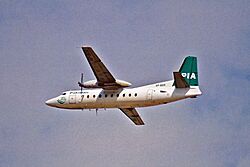Mushaf Ali Mir facts for kids
Quick facts for kids
Air Chief Marshal
Mushaf Ali Mir
NI(M), HI(M), SI(M), SBt
|
|
|---|---|
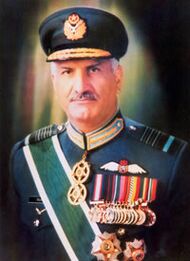
ACM Mushaf Ali Mir (1947–2003)
|
|
| Chief of Air Staff | |
| In office 20 November 2000 – 20 February 2003 |
|
| Preceded by | ACM Pervaiz Mehdi Qureshi |
| Succeeded by | ACM Kalim Sadat |
| Chairman Pakistan Aeronautical Complex | |
| In office 1999–2000 |
|
| Personal details | |
| Born |
Mushaf Ali Mir
5 March 1947 Lahore, Punjab, British India (now Lahore in Punjab in Pakistan) |
| Died | 20 February 2003 (aged 55) Kohat Pass, Kohat District, Pakistan |
| Cause of death | Aviation accident |
| Resting place | Mominpura Cemetery |
| Relatives | Yunus Hussain (brother-in-law) |
| Nicknames | Mashoo Mir |
| Military service | |
| Allegiance | Pakistan |
| Branch/service | Pakistan Air Force |
| Years of service | 1966–2003 |
| Rank | Air Chief Marshal |
| Unit | No. 25 Squadron Night Strike Eagles |
| Commands |
|
| Battles/wars |
|
| Awards |
|
Air Chief Marshal Mushaf Ali Mir was a top officer in the Pakistan Air Force (PAF). He was born on March 5, 1947, and sadly passed away on February 20, 2003. He served as the Chief of Air Staff for the PAF from November 20, 2000, until his accidental death in a plane crash.
Mushaf Ali Mir was known as a skilled fighter pilot and a smart planner. Before leading the air force, he worked in a command role for the ISI, which is Pakistan's main intelligence agency. In 2001–02, he played a key role in planning how the air force would act during a military standoff with India. He also helped the United States military with their supplies for operations in Afghanistan.
His time as Chief of Air Staff ended suddenly when the plane he was traveling in crashed near Kohat, Pakistan. His death has led to many discussions and even some conspiracy theories.
Contents
Biography and Early Life
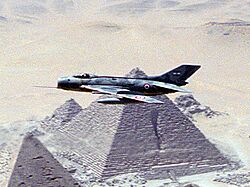
Mushaf Ali Mir was born in Lahore, Punjab, which was part of British India at the time. His family was from Kashmir and followed the Shia branch of Islam. His father, Farzand Ali Mir, was a calligrapher who died when Mushaf was young.
Mushaf went to Govt. Wattan Islamia High School in Lahore. After finishing school, he briefly attended Government College University. However, he decided to join the Pakistan Air Force in 1966, especially after the second war with India. He then went to the famous Pakistan Air Force Academy in Risalpur.
In 1967, he became an officer in the Pakistan Air Force as a Pilot officer. At the PAF Academy, he learned to fly the F-6 Farmer fighter jet. In 1970, he joined the No. 25 Squadron Night Strike Eagles. During the 1971 war, he successfully flew his F-6 Farmer against an Indian Air Force MiG-21 and was credited with shooting it down using a missile.
After the 1971 war, Mushaf Ali Mir continued his education. He attended the PAF Air War College and earned a master's degree in War studies. Later, he went to the National Defence University and got another master's degree in Strategic studies. During this time, he met Brigadier Pervez Musharraf, who would later become a general and president.
Military Career and Key Roles
Early Command Roles
In the 1970s, Mir joined the Combat Commander's School. He started as a student and later became a teacher there. He even commanded a special squadron that used Dassault Mirage IIIER jets to act like enemy planes for training.
As a Wing Commander, he led the No. 33 Wing at the Northern Air Command. Later, he took charge of the Southern Air Command as its Air Officer Commanding. In the 1980s, as a Group Captain, Mir worked as an air attaché at the Pakistani Embassy in Washington, D.C. in the United States.
He also learned to fly the advanced F-16 Fighting Falcon jet.
Important Projects and International Work
In 1994–95, as an Air commodore and ACAS (Plans) at Air AHQ, Mir visited Poland. He discussed buying Russian Su-27 Flanker jets but the deal didn't happen.
In 1995, as an Air vice-marshal, Mir became the Project Director for Project Green Flash. This project aimed to buy Mirage 2000-V jets from France. He worked hard to get these aircraft after testing them himself. In 1996, he also became the Project Director for Project Falcon. This project involved talking with Turkey and Jordan to buy F-16A/B jets.
From 1996 to 1999, Air Vice Marshal Mir commanded the Northern Air Command in Peshawar. During this time, he worked with the ISI and helped provide air support during the civil war in Afghanistan. He also served as a military adviser to the Saudi Arabian Army and briefly commanded Pakistani forces in the Middle East before returning to Pakistan.
In 1999, as an Air Marshal, he became the chairman of the Pakistan Aeronautical Complex in Kamra.
Becoming Chief of Air Staff
In 2000, ACM PQ Mehdi retired. The Pakistan Ministry of Defence sent a list of top air force officers to the President for the highest air force position.
There were six senior air marshals who were considered for the job:
- Air-Mshl. Farooq Qari
- Air-Mshl. Zahid Anis
- Air-Mshl. Qazi Javed Ahmad
- Air-Mshl. Pervez Iqbal Mirza
- Air-Mshl. Riazuddin Shaikh
- Air-Mshl. Mushaf Ali Mir
Many thought the job would go to Air Marshal Farooq Qari or Air Marshal Riazuddin. However, on November 13, 2000, President Rafiq Tarar made a surprising choice. He approved the promotion of Air Marshal Mir, who was the most junior among them, to the rank of four-star air officer. He then appointed him as the Chief of Air Staff.
This unexpected promotion was reportedly requested by Chairman Joint Chiefs General Pervez Musharraf. This decision caused some unhappiness among the other senior air force generals, who then resigned. Despite this, Air Chief Marshal Mir officially took command of the air force on November 20, 2000.
After the terrorist attacks in the United States in 2001, ACM Mir successfully talked with the United States Air Force. He arranged for spare parts and software updates for Pakistan's F-16 jets. During his time, the PAF's F-6 aircraft were retired and given to the Bangladeshi Air Force.
During the military standoff with India, ACM Mir put the air force on high alert. He gave orders to target Indian military positions if needed. Even though he was close to President Musharraf, ACM Mir disagreed with the government's approach to the War on Terror. He worried it might lead to more violence within Pakistan.
Tragic Death in an Air Crash
On February 20, 2003, Air Chief Marshal Mushaf Ali Mir boarded a Fokker F-27 plane. This plane was operated by the Pakistan Air Force. He was traveling with his wife and 15 other senior air force officers. They were flying from Chaklala Air Force Base to Northern Air Command in Kohat. Their trip was to review annual preparations and readiness.
The plane lost contact with military radars and crashed. It hit the highest peak of the mountain in the Tolanj mountain range in Kohat. The crash happened because of very thick fog and cold winter weather. Many other high-ranking air force officers also died in the crash.
After his accidental death, the Pakistani government held a state funeral for him. Many important people from other countries attended. He was buried in Mominpura cemetery in Lahore, Punjab, Pakistan.
The Air Force Flight Safety and the Civil Aviation Authority (CAA) investigated the crash. They concluded that it was an accident, not an act of sabotage. Further investigations in 2015 also confirmed that the aircraft was faulty. The plane had been identified as faulty by the Navy in 1993. It was then transferred to the Army and later to the Air Force, but its problems were never fixed.
Reactions to the Crash
Many countries and officials expressed their sadness after the crash:
 United States: The American ambassador to Pakistan, Nancy Jo Powell, shared her sorrow for the tragic crash on behalf of the United States.
United States: The American ambassador to Pakistan, Nancy Jo Powell, shared her sorrow for the tragic crash on behalf of the United States. Iran: Iranian President Syed Mohammad Khatami sent a message to President Pervez Musharraf. He offered his condolences and prayers for the deceased and their families.
Iran: Iranian President Syed Mohammad Khatami sent a message to President Pervez Musharraf. He offered his condolences and prayers for the deceased and their families. Afghanistan: Afghan President Hamid Karzai sent a message. He expressed deep sorrow and condolences to Pakistan's President, the victims' families, and the people of Pakistan.
Afghanistan: Afghan President Hamid Karzai sent a message. He expressed deep sorrow and condolences to Pakistan's President, the victims' families, and the people of Pakistan. India: The Indian air chief, Air Chief Marshal S. Krishnaswamy, sent sympathies from the Indian Air Force and himself for the sudden death of Mushaf Ali Mir.
India: The Indian air chief, Air Chief Marshal S. Krishnaswamy, sent sympathies from the Indian Air Force and himself for the sudden death of Mushaf Ali Mir. Pakistan: Foreign Minister K.M. Kasuri said that Mushaf Ali Mir's death was a great loss for Pakistan and its military. He called him a great son and a fine soldier whose service would always be remembered.
Pakistan: Foreign Minister K.M. Kasuri said that Mushaf Ali Mir's death was a great loss for Pakistan and its military. He called him a great son and a fine soldier whose service would always be remembered.
Conspiracy Theories and Investigations
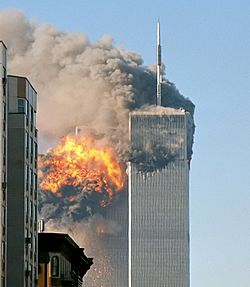
Since the plane crash in 2003, some people have developed conspiracy theories about Air Chief Marshal Mir's death. An American journalist named Gerald Posner claimed in his 2003 book that Mir's death was not an accident but an act of sabotage.
Some American authors who study counterterrorism have suggested that Mir might have known about the terrorist attacks in the United States in 2001 beforehand. They linked this to his time working in the ISI. These authors claimed that Osama bin Laden and others had made a deal with the ISI through Mir in 1996. This deal was supposedly for protection and supplies for Al-Qaeda.
However, in 2015, the Air Force's Flight Inquiry Board and the CAA dismissed these claims of sabotage. After a year-long investigation, they submitted their reports to the Public Accounts Committee of the Pakistani Parliament. They stated that the crash was due to poor maintenance of the aircraft. They showed evidence that the Fokker F27 Friendship plane was known to be faulty. The Pakistan Navy had identified its faults in 1993, and it was later transferred to the Air Force without proper review.
A Pakistani commentator, Najam Sethi, wrote in 2003 that while these claims might be untrue, they were very serious accusations against the Pakistani military.
Awards and Decorations
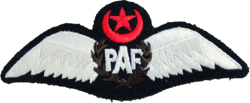 |
|||
| PAF GD(P) Badge RED (More than 3000 Flying Hours) | |||
| Nishan-e-Imtiaz
(Military) (Order of Excellence) |
Hilal-e-Imtiaz
(Military) (Crescent of Excellence) |
||
| Sitara-e-Imtiaz
(Military) (Star of Excellence) |
Sitara-e-Basalat
(Star of Good Conduct) |
Sitara-e-Harb 1965 War
(War Star 1971) |
Sitara-e-Harb 1971 War
(War Star 1971) |
| Tamgha-e-Jang 1965 War
(War Medal 1965) |
Tamgha-e-Jang 1971 War
(War Medal 1971) |
Tamgha-e-Baqa
(Nuclear Test Medal) 1998 |
10 Years Service Medal |
| 20 Years Service Medal | 30 Years Service Medal | Tamgha-e-Sad Saala Jashan-e-
Wiladat-e-Quaid-e-Azam (100th Birth Anniversary of 1976 |
Hijri Tamgha
(Hijri Medal) 1979 |
| Jamhuriat Tamgha
(Democracy Medal) 1988 |
Qarardad-e-Pakistan Tamgha
(Resolution Day Golden Jubilee Medal) 1990 |
Tamgha-e-Salgirah Pakistan
(Independence Day Golden Jubilee Medal) 1997 |
UAE Defence Forces
Unification Medal (UAE) |
| Abu Dhabi Defence Forces
Service Medal (UAE) |
Turkish Legion of Merit
(Turkey) |
Military Merit Order
1st Class (UAE) |
The Legion of Merit
(Degree of Commander) (USA) |
Foreign decorations
| Foreign Awards | ||
|---|---|---|
| UAE Defence Unification Medal | ||
| Abu Dhabi Defence Forces Service Medal | ||
| Turkish Legion of Merit | ||
| Military Merit Order - 1st Class | ||
| The Legion of Merit (Degree of Commander) | ||
See also


